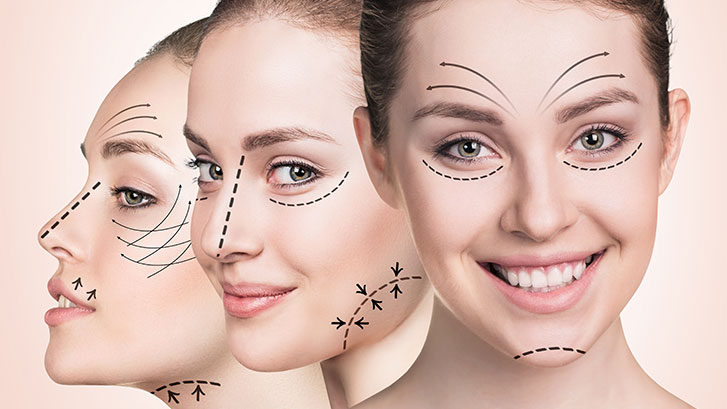Facial Facts: Forehead Lifts Are Sure to Raise Some Eyebrows
If the eyes are the windows to the soul, then the forehead is its awning. Every emotion is amplified across your brow. When you worry, your frown lines tell the world. When you are surprised, the arch of your flesh alerts onlookers, and when you age, the skin along your forehead shows telltale signs in the form of sagging and drooping.
Collagen is the most prevalent protein in the human body. But just because collagen is abundant, that doesn’t mean it springs forth easily. In our younger years, cells regenerate more quickly than when we age. That explains why we require more time to heal from aches, pains, and injuries as we age. However, it also accounts for the proliferation of wrinkles.
Studies have shown how collagen production decreases in our advanced years. Not only does collagen not flow as freely in older individuals, but it also has more difficulty bonding with its surrounding cells. The effect of lowered collagen is essentially a breakdown in communication below the surface of our skin. The fine muscles and soft tissue that give our appearance the support it needs begin to falter.
Nowhere is this dynamic more apparent than on the face. Eyebrows do quite a bit of work, and their diligence is often rewarded with unsightly lines and wear. It is an unfortunate eventuality, but it does not need to persist.
HOW TO ADDRESS DROOPY FOREHEADS
If sagging skin and a generally loose complexion are inhibiting your looks, then a forehead lift may be just what the doctor ordered. By removing excess tissue and tightening the upper features of your face, your surgeon can truly transform your appearance from the top down.
Once the unwanted fat deposits and droopy skin are removed, the surgeon carefully and skillfully contours the forehead to a patient’s realistic and remarkable specifications. The incisions are sutured closed artfully to create an aesthetic masterpiece.
A LIFT TAILORED TO YOUR LOOK
Speaking of incisions, the placement of yours is key to the cosmetic success of a forehead lift. The surgeon will assess your hairline, listen to your aesthetic goals, and determine the best course of action for you. For example, if your coif is encroaching on your brow, then you may want your forehead to be extended upward. This creates a more alert appearance and reverses any issues you may have with a compact brow.
On the other hand, some patients complain of an oversized forehead. In these cases, the incision must respect the contours of the face and bring the hairline and the brow together harmoniously.
To get a detailed picture of your physiology, we may use an endoscopic approach to the brow lift procedure. By inserting a tiny camera through the gentle incision along your hairline, we can map out the tissue lining the upper face. This guides us forward, informing our surgical team where to focus our efforts to most effectively and beautifully lift your look.
HOW INVASIVE IS A FOREHEAD LIFT?
The benefits of a forehead lift are tremendous, but the process does not need to be as extensive as other cosmetic procedures. A full face and/or neck lift is ideal for patients seeking a holistic approach to the sagging effects of time. These procedures pull back sagging jowls, smoothes out the wrinkles around the temples, and generally perks up your appearance.
A forehead lift, however, is less invasive. It may be the perfect solution for younger patients who struggle with the drooping and sagging that are often localized along the brow. In fact, Dr. Binder has pioneered the “natural look” temporal lift technique. This targets the outer edges of the forehead, gently raising them so as not to hike the central brow higher in an obvious manner.
A temporal forehead lift from Dr. Binder prevents the unwanted “surprised” expression that bothers some patients. He wants you to enjoy the natural expressions that your face makes so brilliantly without getting in its way.
BROW LIFT RECOVERY TIME
In addition to providing his patients an aesthetic boost, Dr. Binder is dedicated to helping them get back to their daily lives. Recovery from forehead lift surgery is relatively speedy. Dr. Binder’s expert skills minimize bruising and swelling, so most patients can get back to work (and play) in about two or three days.
You will be invited back to our Beverly Hills office for a follow-up visit approximately ten days after your procedure. The doctor will remove your sutures and assess your progress.
COMPLEMENTARY/ALTERNATE PROCEDURES
Dr. Binder is passionate about aesthetics. He believes in unleashing your best self, and wants to work with you to define how that process should proceed. If a forehead lift is not the best remedy for your concerns, then Dr. Binder will let you know. Instead, there may be a number of alternative approaches that we can pursue to ignite your inner glow.
For example, there are two major forces of nature that contribute to the wrinkles on the upper face: gravity and deterioration. As collagen production decreases, the soft tissue below the skin gets less support. This creates gaps along the face. When the skin above these gaps interact with gravity, it sags and puckers.
Dr. Binder and his associates can fill those gaps with a dermal injection. Fillers like Restylane and Juvederm plump the skin and perk up your perspective! And if the muscles traversing your face have contracted to create frown lines and worry creases, then Dr. Binder can relax your face with the help of a Botox strategy customized to your look.
Regardless of which approach works best for you, Dr. Binder is the best copilot for your aesthetic journey. Contact his office and buckle up for a brighter tomorrow!







 3-D imaging via medical diagnostic tools such as MRIs and CT scanning is completely revolutionizing modern medicine.
3-D imaging via medical diagnostic tools such as MRIs and CT scanning is completely revolutionizing modern medicine.

